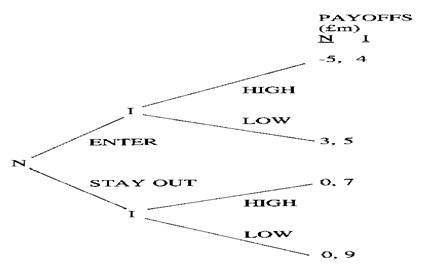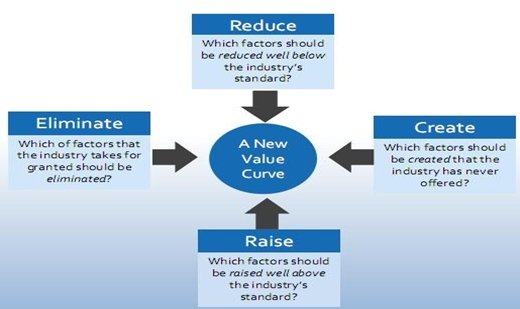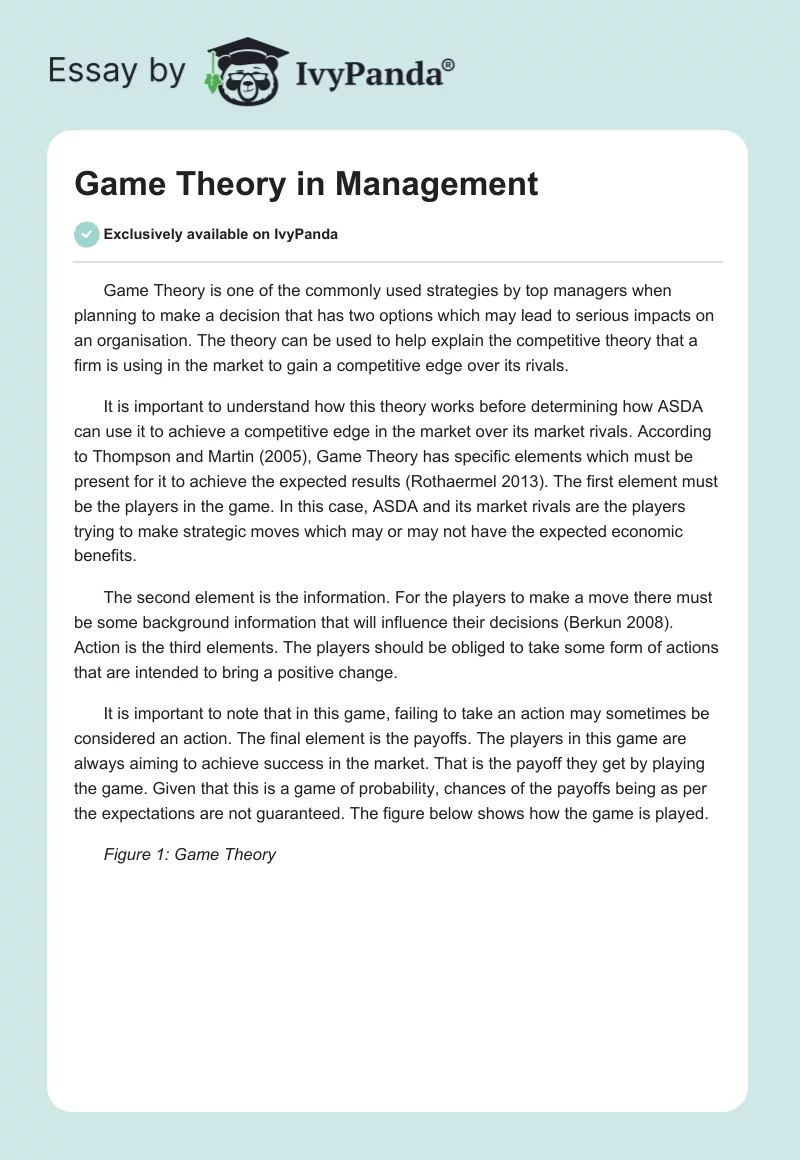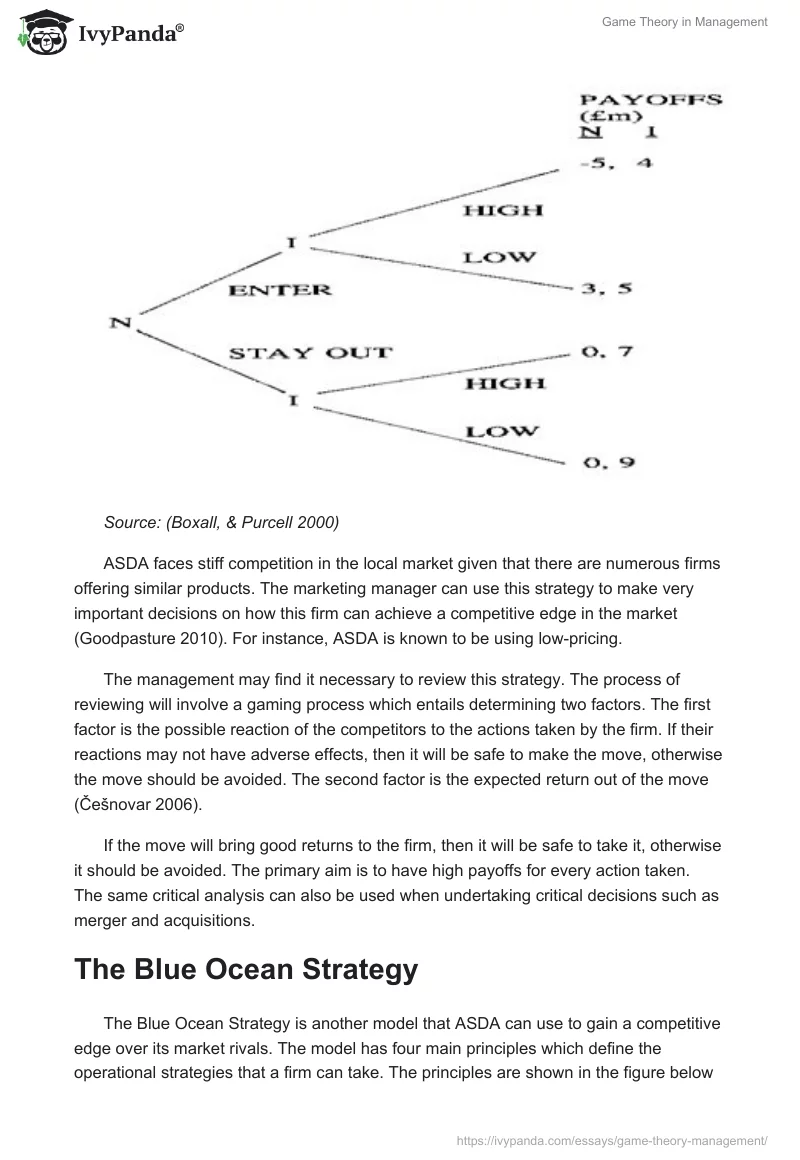Game Theory is one of the commonly used strategies by top managers when planning to make a decision that has two options which may lead to serious impacts on an organisation. The theory can be used to help explain the competitive theory that a firm is using in the market to gain a competitive edge over its rivals.
It is important to understand how this theory works before determining how ASDA can use it to achieve a competitive edge in the market over its market rivals. According to Thompson and Martin (2005), Game Theory has specific elements which must be present for it to achieve the expected results (Rothaermel 2013). The first element must be the players in the game. In this case, ASDA and its market rivals are the players trying to make strategic moves which may or may not have the expected economic benefits.
The second element is the information. For the players to make a move there must be some background information that will influence their decisions (Berkun 2008). Action is the third elements. The players should be obliged to take some form of actions that are intended to bring a positive change.
It is important to note that in this game, failing to take an action may sometimes be considered an action. The final element is the payoffs. The players in this game are always aiming to achieve success in the market. That is the payoff they get by playing the game. Given that this is a game of probability, chances of the payoffs being as per the expectations are not guaranteed. The figure below shows how the game is played.
Figure 1: Game Theory

Source: (Boxall, & Purcell 2000)
ASDA faces stiff competition in the local market given that there are numerous firms offering similar products. The marketing manager can use this strategy to make very important decisions on how this firm can achieve a competitive edge in the market (Goodpasture 2010). For instance, ASDA is known to be using low-pricing.
The management may find it necessary to review this strategy. The process of reviewing will involve a gaming process which entails determining two factors. The first factor is the possible reaction of the competitors to the actions taken by the firm. If their reactions may not have adverse effects, then it will be safe to make the move, otherwise the move should be avoided. The second factor is the expected return out of the move (Češnovar 2006).
If the move will bring good returns to the firm, then it will be safe to take it, otherwise it should be avoided. The primary aim is to have high payoffs for every action taken. The same critical analysis can also be used when undertaking critical decisions such as merger and acquisitions.
The Blue Ocean Strategy
The Blue Ocean Strategy is another model that ASDA can use to gain a competitive edge over its market rivals. The model has four main principles which define the operational strategies that a firm can take. The principles are shown in the figure below
Figure 2: Blue Ocean Theory

Source: (McLoughlin, & Aaker 2014)
The primary focus of this theory is to create new value for the firm that would earn it a competitive edge over its market rivals. According to Meifert, Ulrich, and Potter (2013) this model has evolved over the years, and now many firms are using it differently based on their specific needs. Some are using all the four principles when developing strategies in the market. Others are choosing one or two of the principles to define their actions in the market.
This model may be of critical importance to ASDA in managing the stiff competition in the retail market in the United Kingdom. Of the four strategic principles, this firm has mainly focused on the creation of uncontested market space through reconstruction of market boundaries.
This has been achieved through a unique pricing strategy that this firm uses in the market. The pricing approach used by the firm has enabled it to create uncontested market that is not easily challenged by some of the top market rivals. This has enabled it to reduce the intensity of competitive rivalry in the market, making it one of the most successful retail stores in the United Kingdom.
Game Theory
Game Theory was one of the models that the researcher found to be very appropriate in explaining how ASDA has managed to remain relevant in a market that has increasingly become very competitive. It enabled the researcher to understand the reasons behind the strategy that ASDA uses in the market. As the name suggests, this model is always considered a game of chess or poker where a firm looks at the weaknesses of its rivals and takes advantage of them to gain a competitive edge over them (Nehls 2010).
This firm has been playing this game successfully by taking strategic actions that have made it become very successful. In the section above, the researcher focused on how ASDA uses this strategy to come up with a pricing strategy. Many firms always fear this strategy because of the possibility of triggering price wars in the market.
This theory may help in understanding why this firm chose this route that is always avoided by many firms. The firm must have considered all the forces involved, and the payoffs expected before choosing it. That must be the reason why it brought massive success to the firm despite the dangers that are always associated with it.
Blue Ocean Strategy
Blue Ocean Strategy is another model that was used to analyse the strategies that ASDA has been using in the market based on its four principles of strategic thinking. According to Renn, Allen, and Huning (2011), this model is popular among the marketers when trying to make a series of decisions that can help in improving the operations in the market. It is often used when there is no issue that requires a specific tool to address.
The model made it possible for the researcher to understand that this company has been focused on creation of uncontested market space through reconstruction of market boundaries. Although it is a dominant player in this industry, ASDA has been keen on identifying the gaps in the industry and creating products that can bridge the gaps in the perfect ways possible.
This model enabled the researchers to understand the real reasons why ASDA was using this strategy in the market. It also helped in understanding why this firm has been using pricing strategy in the market to gain a competitive advantage at a time when other major rival firms are using various alternative strategies.
List of References
Berkun, S. 2008, Making Things Happen: Mastering Project Management, O’Reilly Media, Sebastopol.
Boxall, P. & Purcell, J. 2000, ‘Strategic human resource management: where have we come from and where should we be going’, International Journal of Management Reviews, vol. 2, no. 2, pp. 183-203.
Češnovar, T. 2006, ‘The impact of strategic management on business outcomes: Empirical research’, Journal for East European Management Studies, vol. 11, no. 3, pp. 227–243.
Goodpasture, J. 2010, Project Management the Agile Way: Making It Work in the Enterprise, J. Ross Publishers, Ft. Lauderdale.
McLoughlin, D. & Aaker, D. 2014, Strategic market management: Global perspectives, Wiley, Hoboken.
Meifert, M., Ulrich, D. & Potter, L. 2013, Strategic human resource development: A journey in eight stages, Springer, Dordrecht.
Nehls, V. 2010, Private Label Brands at ASDA: Why Supermarket Retailers Should Understand Consumer Behaviour, GRIN Verlag GmbH, Munich.
Renn, R., Allen, D. & Huning, S. 2011, ‘Empirical examination of the individual-level personality-based theory of self-management failure’, Journal of Vocational Behaviour, vol. 32, no. 1, pp. 25-43.
Rothaermel, F. 2013, Strategic management: Concepts, McGraw-Hill Irwin, New York.
Thompson, J. & Martin, F. 2005, Strategic management: Awareness and change, Thomson Learning, London.


